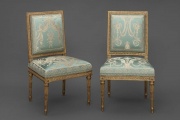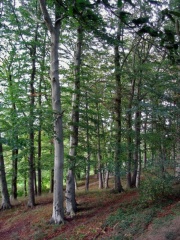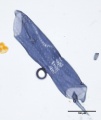Beech
Description
Deciduous, smooth-bark trees of the genus Fagus native to temperate regions of the northern hemisphere. Commonly known varieties are the European beech tree (F. sylvatica) and the American beech (F. grandifolia). The pale reddish-brown, close-grain beechwood is hard and heavy. It bends well, is durable under water, and gives a smooth shiny finish. Beech is a commonly used timber for flooring, cabinetry, furniture (especially bentwood chairs), veneer, plywood, tool handles, and turnery. It was used in panel paintings in western Europe. Beech nuts provide forage for game animals and yield an edible oil.
Synonyms and Related Terms
beechwood; American beech (Fagus grandifolia); European beech (Fagus sylvatica); Bøg (Dan.); hêtre (Fr.); Buche (Deut.); faggio (It.); haya (Esp.); beuk (Ned.); bøk (Nor.); buk (Pol.); bok (Sven.); faia (Port.)
Physical and Chemical Properties
Large trees growing to 35 m. Bark=smooth, gray. Leaves=simple with veins and toothed edges. Fruit=Large husk containing 2 shiny brown edible nuts.
Wood is acidic. Color: Pinkish brown with dark brown rays. Rings: obscure. Pores: diffuse, fine. Grain: faint. Rays: distinct. Hard, strong and heavy. Specific gravity = 0.7-0.9. Density = 43-56 ppcf
Paper fiber type: hardwood, diffuse porous. Using transmitted light microscopy, pulp is identified by medium to long vessels with elongated, alternate pitting. Perforations are simple, but smaller vessels can have scalariform on one end . Appearance with Graff "C" stain: dark blue, but varies with bleaching. Average dimensions of fibers: length, 1.2mm. 21μm wide. Common pulping method: kraft.
Hazards and Safety
Skin contact and dust inhalation may cause irritation and allergies.
May evolve volatile organic acids.
Additional Information
Schoch, W., Heller, I., Schweingruber, F.H., Kienast, F., 2004:Wood anatomy of central European Species: Beech,Fagus sylvatica L.
Additional Images
Sources Checked for Data in Record
- R. J. Gettens, G.L. Stout, Painting Materials, A Short Encyclopaedia, Dover Publications, New York, 1966 Comment: American beech = Fagus americana
- Hardwood Manufacturers Institute, Memphis Tenn.: air-dry weight = 44 pcf
- Wikipedia: http://en.wikipedia.org/wiki/Beech (Accessed Oct. 8, 2005)
- Encyclopedia Britannica, http://www.britannica.com 'Beech' Retrieved May 24, 2003.
- G.S.Brady, Materials Handbook, McGraw-Hill Book Co., New York, 1971 Comment: p.93
- Dictionary of Building Preservation, Ward Bucher, ed., John Wiley & Sons, Inc., New York City, 1996
- Hermann Kuhn, Conservation and Restoration of Works of Art and Antiquities, Butterworths, London, 1986
- Caring for your Collections, Arthur W Schulz (ed.), Harry N. Abrams, Inc. , New York, 1992
- F. H. Titmuss, Commercial Timbers of the World, The Technical Press Ltd., London, 1965 Comment: weight = 45-55 ppcf
- Michael McCann, Artist Beware, Watson-Guptill Publications, New York City, 1979
- George Savage, Art and Antique Restorer's Handbook, Rockliff Publishing Corp, London, 1954
- Pam Hatchfield, Pollutants in the Museum Environment, Archetype Press, London, 2002 Comment: highly acidic
- CRC Handbook of Chemistry and Physics, Robert Weast (ed.), CRC Press, Boca Raton, Florida, v. 61, 1980 Comment: density=43-56 ppcf (0.7-0.9 g/cm3)
- Marja-Sisko Ilvessalo-Pfäffli. Fiber Atlas: Identification of Papermaking Fibers (Springer Series in Wood Science). Springer, 1995.
- Walter Rantanen. "Fiber ID Course." Integrated Paper Services. June 2013. Lecture.








